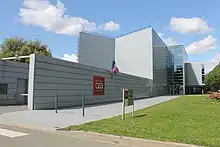CEA Paris-Saclay | |
 East entrance of Saclay site of CEA Paris-Saclay center | |
| Formation | March 1, 1946 |
|---|---|
| Location |
|
| Christian Bailly, director (2021–present) | |
Parent organization | French Alternative Energies and Atomic Energy Commission (CEA) |
| Website | www |
Formerly called | CEA Saclay center (+ separate sites) |
The CEA Paris-Saclay center is one of nine centers belonging to the French Alternative Energies and Atomic Energy Commission (CEA). Following a reorganization in 2017, the center consists of multiple sites, including the CEA Saclay site (formerly a "center"), the Fontenay-aux-Roses site and multiple sites in Paris, Évry, Orsay and Caen.[1]
Historically, as the main Saclay site was the heart of French nuclear research it was called Saclay Nuclear Research Center prior to the shift towards other fields of research and innovation beyond nuclear.[2][3]
The center has close ties with the Paris-Saclay University, being located on the Saclay plateau and active in the Paris-Saclay project for innovation.
Organization

Since February 2017, various sites were grouped together to CEA Paris-Saclay, including[4][1]
History
On 10 October 1945, de Gaulle launched the CEA. The first site to be realized was Fontenay-aux-Roses in 1946. In 1952 the Saclay site was realized. Saclay was much bigger and was chosen in part to be close to the Université Paris-Sud (which today is part of Paris-Saclay University).[7]
The Saclay site was designed by the architect Auguste Perret.[8]
Research
The complex employs more than 7,500 scientists.[7] Multiple domains of research in energy and other fields are represented at the various CEA Paris-Saclay laboratories. These include[9]
- Low-carbon energies
- Climate and environment
- Matter and universe
- Health and life sciences
- Technology for industry
Notable subsidiaries
- National Institute for Nuclear Science and Technology (INSTN), which is dedicated to the academic and professional training in the field of atomic energy.
- Saclay Institute of Matter and Radiation (IRAMIS), houses the Lasers, Interactions and Dynamics Laboratory (LIDyL) research unit (French UMR). Anne L'Huillier and Pierre Agostini both attained breakthroughs in attosecond lasers at LIDyL which led to their prize share of the 2023 Nobel Prize in Physics, along with Ferenc Krausz.
- NeuroSpin is a neuroimaging research center with some of the most powerful MRI machines in the world
Director of the site
- Christian Bailly (2021–present)[10]
- Michel Bédoucha (2016–2021)[11][12]
- Jacques Vayron (2012–2016)[13]
- Yves Caristan (2005–2012)
- Jean-Pierre Pervès (2000–2005)
- Eliane Loquet (1993–2000)
- Jean Bazin (1990–1993)
- Paul Delpeyroux (–1990)
- ...
- Jean Debiesse (1954–1970)
- Jules Guéron (1951)
People
- Jules Gueron, first director of the CEA's nuclear research center
- Jean-Baptiste Waldner, alumnus
- Étienne Klein, physicist, philosopher of science, author, and radio host
- Anne L'Huillier, ultra-fast laser physics, 2023 Nobel laureate in physics
- Pierre Agostini, pioneer of strong-field laser physics, 2023 Nobel laureate in physics
References
- 1 2 "Institutionnel Plans d'accès". CEA.fr (in French). 2020-08-21. Retrieved 2023-12-09.
- ↑ "Du génie nucléaire au génie biologique" (in French). Retrieved 3 October 2023.
- ↑ Rayner-Canham, Marelene F. (1997). A Devotion to Their Science: Pioneer Women of Radioactivity. Philadelphia, Pa.: Chemical Heritage Foundation. pp. 97–123. ISBN 978-0-7735-6658-3. OCLC 191818978.
- ↑ fontenay-aux-roses
.cea .fr /far /Pages /Le-centre /histoire .aspx - ↑ joliot
.cea .fr /drf /joliot /en /Pages /research _entities /SHFJ /Presentation .aspx - ↑ "CIMAP - Presentation (English)". cimap.ensicaen.fr. Retrieved 28 December 2023.
- 1 2 "Histoire du site CEA de Saclay : Le plus grand centre de recherche en Europe". 2022-11-25. Retrieved 2023-10-08.
- ↑ "CEA de Saclay: le palais de la science d'Auguste Perret" (in French). Retrieved 28 October 2022.
- ↑ "CEA Paris-Saclay : Domaines de recherche". cea.fr. Retrieved 29 December 2023.
- ↑ https://www.linkedin.com/in/christian-bailly
- ↑ https://www.cea.fr/presse/Pages/actualites-communiques/institutionnel/michel-bedoucha-nouveau-directeur-du-centre-cea-de-saclay.aspx
- ↑ https://www.linkedin.com/in/michel-bedoucha-b0645511a
- ↑ "Michel Bédoucha: a new Director for the CEA Saclay Center". cea.fr. 1 July 2016. Retrieved 28 December 2023.